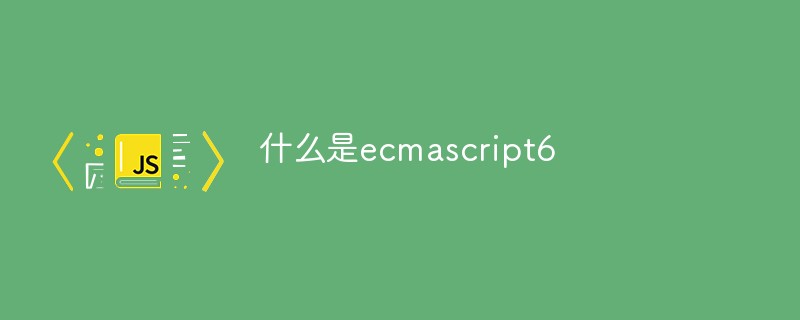Home >Web Front-end >Front-end Q&A >what is ecmascript6
what is ecmascript6
- 藏色散人Original
- 2021-12-02 15:20:461970browse
ecmascript6, referred to as ES6, is a standard for the JavaScript language officially released in June 2015. It is officially called ECMAScript 2015 or ES2015; its goal is to enable the JavaScript language to be used to write complex large-scale applications and become Enterprise-level development language.

The operating environment of this article: Windows 7 system, ECMAScript version 6, Dell G3 computer.
What is ecmascript6?
ecmascript6 Introduction:
ECMAScript 6 (ES6 for short) is a JavaScript language standard officially released in June 2015, officially named ECMAScript 2015 ( ES2015). Its goal is to enable the JavaScript language to be used to write complex large-scale applications and become an enterprise-level development language.
In addition, in some cases, ES6 also refers to the new features of ES2015 and later, although later versions should be called ES7, ES8, etc.
Development History
In 2000, ECMAScript 4.0 began to be brewed. This version did not pass in the end, but most of its contents were inherited by ECMAScript6. Therefore, the starting point for the formulation of ECMAScript6 was actually 2000.
In October 2007, the ECMAScript 4.0 draft was released, and the official version was originally expected to be released in August 2008. However, there are serious differences between the parties on whether to adopt this standard. Large companies, led by Yahoo, Microsoft, and Google, oppose major upgrades to JavaScript and advocate minor changes; Mozilla, headed by JavaScript creator Brendan Eich, insists on the current draft.
In July 2008, because there were too many differences between the parties and the debate was too fierce about which functions should be included in the next version, ECMA decided to suspend the development of ECMAScript 4.0 at a meeting and remove some of the aspects involved in improving existing functions. A small part was released as ECMAScript 3.1, while other radical ideas were expanded and put into later versions. Due to the atmosphere of the conference, the project codename of this version was Harmony. Shortly after the meeting, ECMAScript 3.1 was renamed ECMAScript 5.
In December 2009, ECMAScript 5.0 was officially released. The Harmony project was divided into two. Some more feasible ideas were named JavaScript.next and continued to be developed, and later evolved into ECMAScript 6; some less mature ideas were regarded as JavaScript.next.next and will be developed in the further future. Consider launching again.
In 2011, after the release of ECMAScript 5.1, the development of version 6.0 began.
In March 2013, the ECMAScript 6 draft was frozen and no new features were added. New functionality is envisioned to be put into ECMAScript 7.
In December 2013, the ECMAScript 6 draft was released. This will then be followed by a 12-month discussion period to hear feedback from all parties. Because this version introduces too many grammatical features, and during the formulation process, many organizations and individuals continue to submit new features. The standards committee finally decided that the standard would be officially released once every June as the official version of that year. In the following time, changes will be made based on this version. Until June of the next year, the draft will naturally become the new year's version.
In June 2015, ECMAScript 6 (ES6) was officially adopted and became an international standard. The official name is "ECMAScript 2015" (ES2015 for short).
In June 2016, the slightly revised "ECMAScript 2016" (referred to as ES2016 or ES7) standard was released, which is equivalent to the ES6.1 version, because the difference between the two is very small (only the includes of array instances are added methods and exponential operators), basically the same standard.
Recommended study: "javascript basic tutorial"
The above is the detailed content of what is ecmascript6. For more information, please follow other related articles on the PHP Chinese website!

